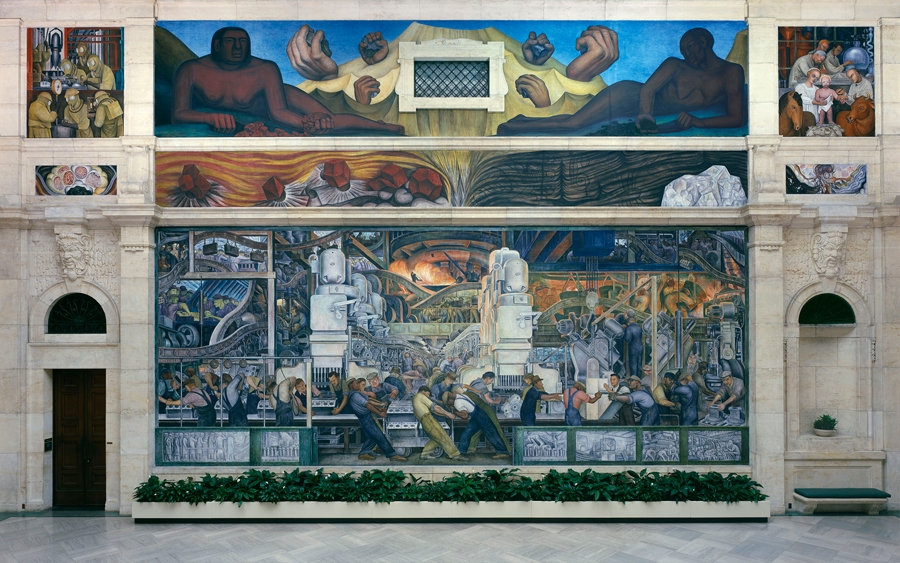Market news in the artworld in the autumn, particularly during the first two weeks of November, is often and rightly dominated by the auctions in New York. There and then one finds the big prices for big game. As of this writing, Sotheby’s had already clocked in a record-breaking $422 million Impressionist and Modern Art auction on 4 November, which was helped along by the $100m paid for Alberto Giacometti’s Chariot (1950). We know what motivates these numbers: a love of art combined with a love of status conferred by big purchases. Economists call the latter ‘conspicuous consumption’ or ‘price utility’: when the numbers themselves create a certain satisfaction, a certain demand. Non-economists know it as Birkin bags.
But three days later, on 7 November, a different $100m turned up in a different arena of market reporting: bankruptcy rulings. That was when the honourable Steven W. Rhodes of federal bankruptcy court approved the plan that will eventually raise the City of Detroit out of the nearly $10 billion sink of unsecured debt that had threatened, among other things, to see the city’s art collection, anecdotally valued in the range of $2.8bn to $4.6bn, sold off and the proceeds disbursed to the city’s creditors. One hundred million dollars is what the Detroit Institute of Art (DIA) and its supporters pledged to the ‘grand bargain’, a 20-year, $816m package of state funds and, significantly, major pledges by some of the US’s biggest foundations, the Ford Foundation among them, in order to keep the art in Detroit.
Economists call it ‘conspicuous consumption’ – when the numbers themselves create a certain satisfaction. Non-economists know it as Birkin bags
Now the DIA and the foundations’ millions ostensibly go to help pay Detroit’s pensioners, just one class of creditors who ultimately agreed to a 54 percent markdown of the $3.1bn they were owed directly by the city – in other words, there was plenty of pain to go around. But those millions would not have materialised at the start if it had not been for the DIA and its collection and what the two represented, not just to the city and its inhabitants, but as embodiments of ideals that can make money purposeful, something more than mere purchasing power.
As the Detroit Free Press reported in its excellent ‘How Detroit Was Reborn’ on 9 November, roughly a year earlier, federal judge Gerald Rosen, the Rhodes-appointed mediator for Detroit’s bankruptcy case and the man responsible for the ‘grand bargain’, had gathered the heads of 12 major foundations in his chambers.
He asked the foundation heads to talk about their areas of interest, probing for who might be willing to help and where. He shared his hope: Raise money to help offset pension cuts and save the DIA. He pitched his appeal to the philanthropic missions in the room – urban revitalization, cultural interests, humanitarian concerns.
Art isn’t central to those missions, but it has its role to play in each and, in certain circumstances, can encapsulate them (think of Theaster Gates or Ai Weiwei). Rosen’s plea set off a cascade of commitments, with one foundation after another promising tens and sometimes, as in the cases of the Ford and Kresge foundations, hundreds of millions of dollars to Detroit’s pensioners and, in turn, to the DIA, whose collection of city-owned art will be transferred to a charitable trust, thus protecting it from any future fiscal upheavals suffered by the city.
The art was central to Rosen’s mission, because it could draw others to act. The art would take the quibbling questions about the past (who owes whom, and how much? Why didn’t I get mine?) and turn them into challenges for the future (what are we going to do? How will we be remembered?). And though it wasn’t at all clear at the time, I’m sure, it makes sense that Rosen found success with the private foundations he approached: those foundations, after all, are the best answers to the question of remembrance.
So with auction season over and the big money counted, we would do well to remember that raising a paddle or casting a nod to the front of the sale room, though conspicuous, is only one of the more minor actions that one can make in the name of art.
This article was first published in the December 2014 issue.
